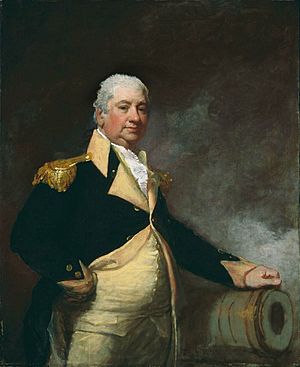Treaty of New York (1790) facts for kids
The Treaty of New York was an important agreement signed in 1790. It was made between leaders of the Muscogee people and Henry Knox, who was the U.S. Secretary of War. Knox worked for President George Washington.

Before this treaty, there was an attempt to make a deal in 1789 in Georgia. But the Muscogee leader, Alexander McGillivray, stopped it. He wrote a letter explaining his concerns. President Washington then sent a special person, Marinus Willett, to talk to McGillivray. Willett convinced McGillivray to come to New York City, which was the capital of the United States at that time. The idea was for McGillivray to meet directly with Washington and Knox.
Contents
What the Treaty Agreed To
In the summer of 1790, twenty-seven Muscogee leaders, led by McGillivray, traveled to New York. They signed the treaty for the "Upper, Middle, and Lower Creek and Seminole" groups, who were part of the Creek nation. McGillivray, who knew about European laws from his Scottish father, formally signed for his people.
Land and Boundaries
The Muscogee leaders agreed to give up a large part of their hunting lands to the United States. This land stretched to the Oconee River. They also agreed to return any enslaved African-Americans who had run away to their territory. However, the Muscogee leaders said it would be very hard to get their people to follow these new land lines and return the runaway enslaved people.
Rules for Justice
The United States gave the Muscogee the right to punish people who were not Native American but came onto their land without permission. However, the Muscogee were not allowed to punish non-Native Americans who committed crimes on Creek lands. Instead, the Muscogee agreed to send any member of their tribe accused of crimes to U.S. courts.
Help and Special Agreements
The treaty also promised the Muscogee tribes agricultural supplies and tools to help them with farming. In a special agreement, Alexander McGillivray was also made a brigadier (a type of general) in the United States Army. He received a yearly salary of $1,500. McGillivray was also allowed to bring goods into the country through the Spanish port of Pensacola, Florida without paying American taxes. He also received $100,000 because his father's lands had been taken.
Why This Treaty Was Important
The Treaty of New York was the first treaty between the United States and Native Americans that was not signed on land controlled by Native Americans. This was a new way of doing things.
Challenges After the Treaty
Historian Joseph J. Ellis explained that President Washington hoped to stop Native American groups from being forced off their lands. Washington even imagined that Native American nations might one day become U.S. states. However, Ellis says the treaty did not fully work. The U.S. government's military was not strong enough to protect the borders of Muscogee territory. Because of this, white American settlers moved into the Muscogee lands, even though the treaty said they shouldn't.
Images for kids
-
A painting of Henry Knox, who helped sign the treaty.


